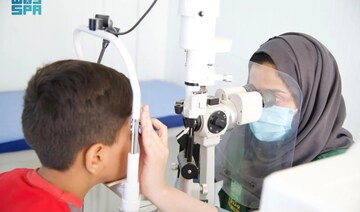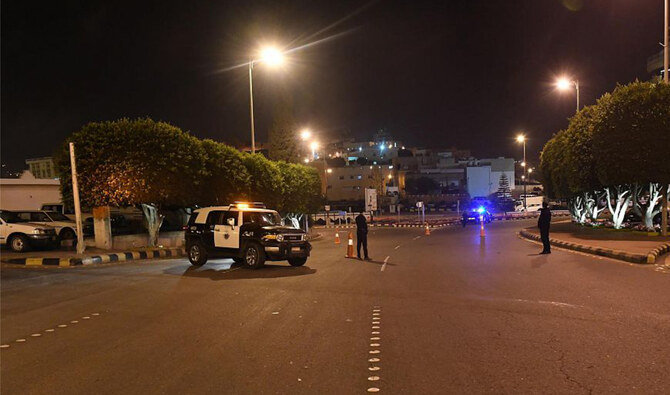DHAHRAN: The King Abdulaziz Center for World Culture launched a contemporary art exhibition, called “Net Zero,” in Dhahran on Wednesday.
In what Ithra describes as a “future-forward, sustainable approach to museums and exhibitions,” the futuristic, 3D-printed white walls in Gallery 1 came to life in the latest thought-provoking group show, made up of colorful and organic immersive dioramas from 18 different contemporary artists.
The eclectic mixture of independent but cohesively curated artworks showcases how different artists use their art as a way to communicate the need to try to achieve “net zero,” which is a term used to refer to “the balance between the amount of greenhouse gas produced and the amount removed from the atmosphere.”
Farah Abushullaih, the head of the museum at Ithra, explained why the activation of the space was timely.
She said: “The ‘Net Zero’ exhibition aims to raise awareness and educate our audiences on sustainability from an artistic perspective.
“Part of Ithra’s mission is to educate the community on artistic practices, how artists reflect the world and engage with important and topical areas of interest through creativity.”
The exhibition space adopted sustainable operations throughout the construction process, and promises to keep that ethos following the end of the event in June 2024.
The plan is to disassemble the exhibition as a whole once it ends and to repurpose the low-carbon walls and reuse most materials within the Ithra facility.
Ithra demonstrated its commitment to the cause by partnering with ACCIONA Cultural for the first time for “Net Zero.”
ACCIONA Cultura is a global company that specializes in the creation of museums and immersive experiences with an innovative and sustainable approach to develop carbon tracking and offsetting solutions, including in the design, production, installation, and operational phases of events.
There are two Saudi artists and 16 other artists participating in “Net Zero.” The 18 artists have brought their personal observations of environmental challenges to their work.
The artworks, nine of which have been commissioned specifically for the exhibition, convey the contributing artists’ perspectives on a range of environmental issues.
Mohammad Al-Faraj, one of the Saudi artists, is also a farmer. Hailing from neighboring Al-Ahsa, Al-Faraj takes great pride in documenting the lives of rice farmers.
He started filming the men with feet submerged in water in 2015, tirelessly harvesting the famous hassawi red rice. Some of the footage was taken on his smartphone, some with his professional camera. The result was the first of his three pieces in his “Net Zero” contribution.
On a TV hanging on the wall, a split-screen shows footage of men harvesting the rice, their chanting in unison reverberating in the sun. The five-minute visual collage consists of snippets stitched together, each showcasing a different glimpse in the life of a rice farmer throughout the process — and the years.
Al-Faraj told Arab News: “I call this first work ‘The Ghost of the Farmer.’ I’m not a nostalgic person and don’t necessarily long for the ways of the past, but I do have a fear of the future.
“I am afraid that things, and processes, that I will need later, are disappearing. I can already feel them leaving, like a ghost.
“When I refer to farmers, I don’t just limit it to those in the farming industry. We are all farmers, each of us, in our lives, we have a garden within.
“How you cultivate the space, how you care for it, how you nurture it and water it — it’s a garden. There is the saying that goes something like, ‘Each of us has a life that is a canvas,’ but I think, in actuality, a garden is more fitting because it lives and dies, just like us.”
For his second piece, “Fossils of Knowledge,” he shaped organic objects from a tree to resemble a giant fossil. He questions where the knowledge that one acquires goes when we are dead and buried.
In his third piece he stitched together a collection of black and white photos that show the lifecycle of the palm tree, from a freshly chopped stump that resembles a full moon to burning the soil deliberately to reignite the land. Images of palm trees twisting with nature and then of its renewed growth, all connected. Printed on cotton paper, he sees it all as one photo.
Al-Faraj says that it means a great deal to him to have his work displayed so close to his beloved Al-Ahsa. Dhahran has become a hub and he said he is honored to be part of the very important conversations that Ithra promotes.
Aaron Cezar, director of Delfina Foundation in London, traveled to the first night of the “Net Zero” show in support of Al-Faraj, who had been offered a Delfina residency back in 2016.
The foundation had identified Al-Faraj as an exceptional artist, with what Cezar described as having an “incredible eye for moving images and for storytelling.”
Cezar kept in touch with Al-Faraj and has followed his work since then.
He told Arab News: “I think Mohammad Al-Faraj is one of the artists who will be at the forefront of this next generation of creative practitioners and I’m here to support him.
“He is from Al-Ahsa, too, which is important — he is not from Riyadh or Jeddah. He pretty much lives there (in Al-Ahsa). He is bringing in the stories, the way of life from this other province of Saudi into the national scene, and then occasionally on the international scene as well.”
The other Saudi artist participating is Zahrah Al-Ghamdi, who has long established herself as a local pioneer in utilizing nature as the main focus of her art.
As a frequent participant in art exhibitions nationally and internationally, she has become one of the most recognized contemporary Saudi artists of our time. Her work with organic materials, while drawing inspiration from the land by using objects found within that land, has become the blueprint for artists.
For “Net Zero,” Al-Ghamdi’s site-specific piece “City of Thorns” is made entirely of thorns and brown-tinted leaves stuck together in a circular shape.
The work is meant to be seen “as a symbol of the resilience of nature. It highlights the impact of climate change, underscoring the responsibility we bear to protect the natural environment for future generations.”
The exhibition promises to take an interactive approach to educate the public beyond the enjoyment of the space. The aim is to build awareness around sustainability by collaborating with the community and inviting the public to join concurrent comprehensive public programming that includes interactive workshops and sessions on recycling.
The other 16 artists are: Moffat Takadiwa, Ava Roth with Mylee Nordin, Bright, Ugochukwu Eke, SUPERFLEX, Dina Haddadin, Ane Graff, Willy Verginer, Ian Kiaer, Tom Hegen, Emil Lukas, Ron Griffin, Nick Brandt, Gregory Mohoney, Hamish Fulton, Philippe Parreno and Jan Dibbets.
New ‘Net Zero’ exhibition opens at Ithra aiming to build awareness around sustainability
https://arab.news/v6q5y
New ‘Net Zero’ exhibition opens at Ithra aiming to build awareness around sustainability

- Two Saudis among 18 participating artists
- Event set to end in summer 2024































